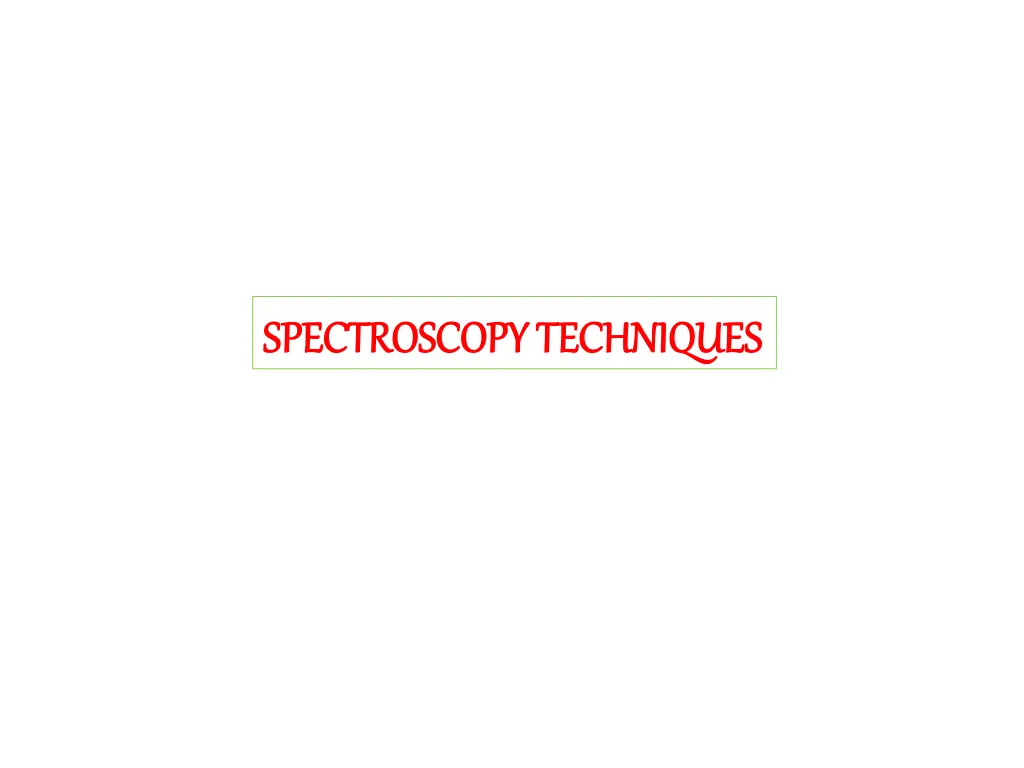
Advanced Spectroscopy Techniques for Detailed Analysis
Explore a visual journey through various advanced spectroscopy techniques used for in-depth analysis in scientific research and applications. From UV-Vis spectroscopy to Raman spectroscopy, these images provide a glimpse into the world of spectroscopic analysis.
Download Presentation

Please find below an Image/Link to download the presentation.
The content on the website is provided AS IS for your information and personal use only. It may not be sold, licensed, or shared on other websites without obtaining consent from the author. If you encounter any issues during the download, it is possible that the publisher has removed the file from their server.
You are allowed to download the files provided on this website for personal or commercial use, subject to the condition that they are used lawfully. All files are the property of their respective owners.
The content on the website is provided AS IS for your information and personal use only. It may not be sold, licensed, or shared on other websites without obtaining consent from the author.
E N D
Presentation Transcript
SPECTROSCOPY TECHNIQUES SPECTROSCOPY TECHNIQUES
Handheld, portable, and compact FTIR Some samples cannot easily be moved because they are too large (e.g., aircraft) or too delicate and precious (e.g., artworks). Others might need to be analyzed on the spot (such as environmental or forensic samples). If the sample cannot come to the FTIR instrument, the instrument needs to go to the sample. The Agilent 4300 handheld FTIR spectrometer is a lightweight, robust handheld FTIR spectrometer ideal for mobile, nondestructive testing in field and nonlaboratory environments. The FTIR and 5500 Series compact FTIR complete the Agilent portfolio of rugged, portable FTIR analyzers for field applications. Agilent 4500 Series portable
X-ray photoelectron spectroscopy (XPS) is widely used to analyze the elemental composition and chemical state of the materials. By detecting the kinetic energy of ejected photoelectrons, the electron binding energy can be calculated from their wavelength in the given energy of the incident X-rays. XPS is a surface-sensitive quantitative spectroscopic technique that measures the elemental composition at the parts per thousand range, chemical state and electronic state of the elements that exist within a material.
X-ray photoelectron spectroscopy (XPS) is a non-destructive technique that analyzes the surface chemistry of a material by measuring the energy levels of photoelectrons: How it works XPS measures the kinetic energy of ejected photoelectrons to calculate the electron binding energy. The binding energy is characteristic of each element, and is related to the nature and strength of the chemical bonds. What it can measure XPS can measure the elemental composition, chemical state, and electronic state of the atoms in a material. It can also determine the relative abundances of components on surfaces.
What it can be used for XPS is used to characterize the surfaces of many materials, including inorganic compounds, semiconductors, organic compounds, and thin films. It can also be used to support research on surface- mediated processes. Sample requirements Samples should be dry and solid, such as powders, coatings, or thin films. The preferred sample dimensions are about 1x1cm. Also known as XPS is also known as electron spectroscopy for chemical analysis (ESCA).
